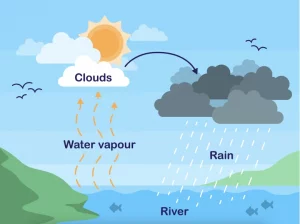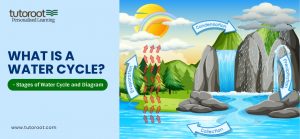What is a Water Cycle? Stages of Water Cycle and Diagram
Introduction
The water cycle, also known as the hydrological cycle, is a fundamental concept in biology and earth sciences. It refers to the ongoing circulation of water above, on, and beneath the Earth’s surface. This process is vital for sustaining life, regulating climate, and maintaining ecosystems. Water in different forms—liquid, vapour, and ice—travels through various stages, from the atmosphere to the earth and back, in a never-ending cycle. Understanding the water cycle is essential for students to grasp how our planet’s water resources are replenished and how they support life on Earth.
What is the Water Cycle?
The water cycle is a natural process that circulates water through the environment, connecting the atmosphere, land, and oceans. It is a closed system, meaning that the water present on Earth today is the same water that has been circulating for millions of years. The water cycle is driven by solar energy, which powers the movement of water through different stages—evaporation, condensation, precipitation, and collection.
In simple terms, the water cycle involves the transformation of water from one state to another—liquid to gas, gas to liquid, and sometimes solid. Water evaporates from the surface of oceans, rivers, and lakes due to the sun’s heat, rising into the atmosphere as water vapour. This vapour then cools and condenses to form clouds. When these clouds become heavy with moisture, they release it in the form of precipitation, which can be rain, snow, sleet, or hail. The precipitation then returns to the Earth’s surface, where it either soaks into the ground, replenishing groundwater supplies or flows back into bodies of water, continuing the cycle.
The water cycle is not just a simple circular process; it also includes important interactions between various components of the Earth’s system. For example, water can be stored in glaciers, absorbed by plants and animals, or even seep into underground reservoirs. This continuous movement of water ensures that life on Earth has access to fresh water, making the water cycle a crucial part of our planet’s natural processes.
Simple Water Cycle Diagram
To better understand the water cycle, it is helpful to visualize it through a simple diagram. A basic diagram of the water cycle usually shows the essential stages: evaporation, condensation, precipitation, and accumulation. In this diagram, arrows are used to show the movement of water between the atmosphere, land, and bodies of water.
- Evaporation: The process where water turns from liquid to vapour and rises into the atmosphere.
- Condensation: The process where water vapour cools and changes back into liquid droplets, forming clouds.
- Precipitation: The release of water from clouds in rain, snow, or other types of precipitation.
- Collection: The process where water gathers in oceans, rivers, lakes, and underground aquifers, ready to begin the cycle again.
A simple water cycle diagram aids students in understanding how water travels through the environment and how the various stages are linked together. This visualization can be a useful tool in classrooms to reinforce the understanding of the water cycle process.
Water Cycle Diagram

Complete Water Cycle Process
The water cycle process is a continuous, dynamic system that plays a crucial role in sustaining life on Earth. Understanding this process involves looking at each stage in detail and how they connect.
The cycle begins with evaporation, where water from oceans, lakes, and rivers is heated by the sun and converted into water vapour. This vapour ascends into the atmosphere, carrying along any impurities and salts. Alongside evaporation, transpiration occurs, which is the process where plants release water vapour from their leaves into the atmosphere. Together, these processes are sometimes referred to as evapotranspiration.
Once in the atmosphere, the water vapour cools and undergoes condensation. This process involves the water vapour turning back into liquid droplets, forming clouds. As the clouds accumulate more moisture, they become heavier, eventually leading to precipitation. Precipitation occurs in various forms, such as rain, snow, sleet, or hail, depending on the temperature and atmospheric conditions.
When precipitation falls to the ground, it follows different paths. Some of the water infiltrates the soil, replenishing groundwater supplies, while the rest may flow over the surface as runoff, eventually finding its way back to oceans, rivers, and lakes. This part of the cycle, known as collection, is crucial as it allows the water to return to large bodies of water, where it can once again be heated by the sun and evaporated, continuing the cycle.
The water cycle is not just a simple loop but involves complex interactions between the atmosphere, biosphere, lithosphere, and hydrosphere. This process is responsible for distributing water across the planet, making it available for various ecosystems and human use. The water cycle also plays a key role in weather patterns, climate regulation, and the distribution of nutrients within ecosystems.
Stages of Water Cycle
The water cycle can be broken down into several stages, each playing a vital role in the movement of water through the environment. The primary stages consist of evaporation, condensation, precipitation, and collection. Let’s explore each stage in detail.
- Evaporation: Evaporation is the process where water is heated by the sun and transformed from a liquid into a gas, known as water vapour. This stage is crucial as it marks the beginning of the water’s journey from the Earth’s surface to the atmosphere. The speed at which evaporation occurs is influenced by factors like temperature, humidity, and wind conditions. Evaporation occurs not only from large bodies of water like oceans and lakes but also from soil and vegetation. Through evaporation, impurities are left behind, resulting in the purification of water as it enters the atmosphere.
- Condensation: After evaporation, the water vapour rises into the cooler parts of the atmosphere, where it undergoes condensation. Condensation is when water vapour cools and transitions back into liquid, forming tiny droplets that gather to create clouds. These droplets are too small to fall as precipitation but play a crucial role in cloud formation. Condensation is also responsible for the formation of dew and fog near the Earth’s surface. The level of condensation in the atmosphere can affect weather patterns and the development of different cloud types.
- Precipitation: When clouds accumulate enough moisture, they eventually release it in the form of precipitation. Precipitation happens when water droplets in clouds merge into larger drops that become too heavy to stay aloft. Depending on the temperature, precipitation can fall as rain, snow, sleet, or hail. Precipitation is essential for replenishing freshwater sources on Earth, including rivers, lakes, and aquifers. It also plays a significant role in supporting plant life, agriculture, and replenishing drinking water supplies. The type and amount of precipitation differ based on region and are shaped by factors such as geographical location and climate.
- Collection: Once precipitation reaches the Earth’s surface, it undergoes collection, the final stage of the water cycle. Collection involves the gathering of water in various forms, such as runoff into rivers and lakes, infiltration into the soil to replenish groundwater, and direct flow into oceans and seas. This stage is crucial for maintaining the Earth’s water supply and ensuring that the water is available for the next cycle. The collection also includes water that plants absorb and later release back into the atmosphere through transpiration. This interconnected process ensures the continuous movement of water through the environment.
Final Notes
The water cycle is a vital natural process that supports life on Earth by maintaining the continuous flow of water among the atmosphere, land, and oceans. Understanding the stages of the water cycle—evaporation, condensation, precipitation, and collection—provides valuable insights into how our planet’s water resources are maintained and distributed. Visualizing the water cycle through diagrams can further enhance comprehension, making it easier for students to grasp the interconnectedness of these stages.
If you’re looking for more explanations like this one, visit the Tutoroot Blog for a wide range of simplified learning materials. To take your understanding even further, consider Tutoroot’s Biology Online Tuitions. With personalised online tuition sessions, you can master any subject at your own pace. Get started today by scheduling a FREE DEMO session and experience the benefits of online home tuition with Tutoroot.
FAQs
What are the 7 steps of the water cycle?
The water cycle can be divided into seven steps: evaporation, transpiration, condensation, precipitation, runoff, infiltration, and collection.
What are the 4 stages of the water cycle?
The water cycle’s four key stages are evaporation, condensation, precipitation, and collection.
Explain the water cycle?
The water cycle is a continuous process that moves water through the environment, involving stages such as evaporation, condensation, precipitation, and collection, ensuring the distribution and replenishment of Earth’s water resources.

